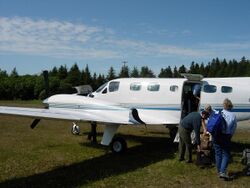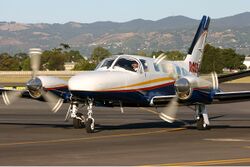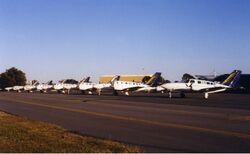Engineering:Cessna 441 Conquest II
| Cessna 441 Conquest II | |
|---|---|

| |
| Role | Utility aircraft |
| National origin | United States |
| Manufacturer | Cessna |
| First flight | January 10, 1977[1] |
| Produced | 1977–1986[2] |
| Number built | 362[2] |
| Developed from | Cessna 404 Titan |
The Cessna 441 Conquest II is the first turboprop powered aircraft designed by Cessna, and was meant to fill the gap between their jets and piston-engined aircraft. It was developed in November 1974, with the first aircraft delivered in September 1977. It is a pressurized, 8–9 passenger turbine development of the Cessna 404 Titan.
Development
The original design from 1972 for this aircraft was known as the Model 435 and was to be powered by Continental GTSIO-520X engines with three-bladed propellers. By 1975, the designed evolved into the turboprop-powered Model 441.[1] It was certified by the FAA on August 19, 1977.[3] Cessna renamed the Model 441 the Conquest II in 1983. 1984 models starting with constructor number 195 used lighter-weight, four-bladed McCauley propellers.[1] A 441 with Pratt & Whitney Canada PT6A-112 turboprops was flown in 1986, but did not enter production. A smaller aircraft was marketed as the Cessna 425 Conquest I, itself a turbine development of the Cessna 421.
In September 2007, Cessna limited the Conquest II to 22,500 hours of air time through a Supplemental Inspection Document. This makes it effectively mandatory for US air carriers but only advisory for private operators.[4] Cessna built 362 of the aircraft between 1977 and 1986.[2]
Design
The Cessna 441 cruises at 316 kn (585 km/h) TAS while burning 480 lb (220 kg) of fuel per hour at FL290, while maximum range is 2,000 nmi (3,700 km) at 260 kn (480 km/h) TAS and 310 lb (140 kg)/h at FL350. With six to nine seats, its 6,400–6,500 lb (2,900–2,900 kg) basic operating weight (BOW) allows a 200–300 lb (91–136 kg) payload at full fuel, but MTOW can be increased by 490 lb (220 kg) with aftermarket modifications. Most have been upgraded from twin Garrett TPE331-8s engines to -10s for better climb performance, a ceiling raised to FL350 from FL330, and TBO raised from 3,000 to 5,000h for $225,000 per engine.[2]
Converting from the standard three-blade propellers to smaller diameter Hartzell four-blade propellers results in a climb rate improved by 200 fpm (1.01 m/s) and a 5 kn (9.3 km/h) increase in cruise speed as well as reducing cabin noise and improving ground clearance.[5] The aircraft has a retractable tricycle landing gear and has a ground roll of 1,785 ft (544 m) on takeoff. The high aspect ratio wings use bonded construction techniques.[6] The ICAO designator for the Cessna Conquest as used in flight plans is C441.
Operational history
By May 2019, 290 aircraft remained in service, at a $.75-.9M value down from $1-1.9M in 2011. The King Air B200 has a roomier cabin but 200 nmi (370 km) less range, a slower cruise and higher fuel burn. The Mitsubishi MU-2B-60 has a similar fuel burn and speed but flies lower. The Piper Cheyenne III is fast but has poorer fuel efficiency and 250 nmi (460 km) less range. The Piper Cheyenne 400 is 45 kn (83 km/h) faster but burns fuel like a light jet.[2]
The Conquest II is operated by corporate owners, air charter operators and previously by the Royal Flying Doctor Service in Australia. Examples of the type have been exported to many countries including Austria, Australia, Canada, Ecuador, Finland, Germany, Iceland, Mexico, Norway, Peru, South Africa, Sweden and the United Kingdom.
Specifications (Conquest II)
General characteristics
- Crew: 1 or 2 pilots
- Capacity: 8–10 passengers
- Length: 39 ft 0 in (11.89 m)
- Wingspan: 49 ft 4 in (15.04 m)
- Height: 13 ft 2 in (4.01 m)
- Wing area: 253.6 sq ft (23.56 m2)
- Aspect ratio: 9.6:1
- Airfoil: NACA 23018 at root, NACA 23019 at tip
- Empty weight: 5,682 lb (2,577 kg)
- Gross weight: 9,850 lb (4,468 kg)
- Powerplant: 2 × Garrett TPE331-8-403S turboprops, 636 shp (474 kW) each
- Propellers: 4-bladed McCauley
Performance
- Maximum speed: 340 mph (550 km/h, 300 kn) at 16,000 ft (4,875 m)
- Cruise speed: 298 mph (480 km/h, 259 kn) at 35,000 ft (10,700 m)
- Stall speed: 86 mph (139 km/h, 75 kn) flaps and gear down
- Range: 2,525 mi (4,064 km, 2,194 nmi) at 35,000 ft (10,700 m)
- Service ceiling: 35,000 ft (11,000 m)
- Rate of climb: 2,435 ft/min (12.37 m/s)
Avionics
- Cessna 1000A Integrated Flight Control System
See also
Aircraft of comparable role, configuration and era
- Beechcraft King Air
- Mitsubishi Mu-2
- Piper PA-42 Cheyenne
- Swearingen Merlin
References
- ↑ 1.0 1.1 1.2 Phillips, Edward H.: Wings of Cessna, Model 120 to the Citation III, Flying Books, 1986. ISBN:0-911139-05-2
- ↑ 2.0 2.1 2.2 2.3 2.4 Fred George (May 22, 2019). "Cessna Conquest II: Undervalued, Speedy, Fuel Efficient Turboprop". Business & Commercial Aviation. https://aviationweek.com/business-aviation/cessna-conquest-ii-undervalued-speedy-fuel-efficient-turboprop.
- ↑ "Type Certificate data sheet No. A28CE". FAA. July 29, 2015. http://rgl.faa.gov/Regulatory_and_Guidance_Library/rgMakeModel.nsf/0/521560cf1070e2f286257ed7005deb79/$FILE/A28CE_Rev_13.pdf.
- ↑ "FAA Clarifies Cessna's Life Limit For The 441 Conquest II". AVweb. September 7, 2007. http://www.avweb.com/avwebflash/news/FAAClarifiesLifeLimitForThe441ConquestII_196092-1.html.
- ↑ Huber, Mark (October 2008). "Cessna 441 Conquest II". Business Jet Traveler. http://www.bjtonline.com/business-jet-news/cessna-441-conquest-ii.
- ↑ Alan Healy (October 1977). "The New Cessna Conquest". Air Progress.
External links
| Wikimedia Commons has media related to: |
 |




